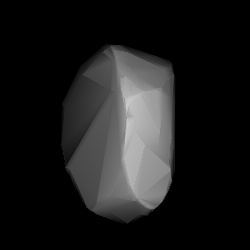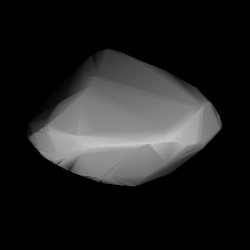Related Research Articles
627 Charis is an asteroid and the parent body of the Charis family, located in the outer regions of the asteroid belt, approximately 49 kilometers in diameter. It was discovered on 4 March 1907, by German astronomer August Kopff at the Heidelberg-Königstuhl State Observatory in southwest Germany. The asteroid was named after the Greek goddess Charis, a name which may have been inspired by the asteroid's provisional designation 1907 XS.
1764 Cogshall, provisional designation 1953 VM1, is a carbonaceous Themistian asteroid from the outer regions of the asteroid belt, approximately 26 kilometers in diameter. It was discovered on 7 November 1953, by astronomers of the Indiana Asteroid Program at Goethe Link Observatory in Indiana, United States. The asteroid was named after Wilbur Cogshall, professor of astronomy at Indiana University.

1129 Neujmina is an Eos asteroid from the outer regions of the asteroid belt. It was discovered on 8 August 1929, by astronomer Praskoviya Parchomenko at the Simeiz Observatory on the Crimean peninsula. The stony S-type asteroid has a rotation period of 5.1 hours and measures approximately 34 kilometers in diameter. It was named after Soviet astronomer Grigory Neujmin.

1133 Lugduna, provisional designation 1929 RC1, is a stony Florian asteroid from the inner regions of the asteroid belt, approximately 9.5 kilometers in diameter. It was discovered on 13 September 1929, by Dutch astronomer Hendrik van Gent at the Leiden Southern Station annex to the Union Observatory in Johannesburg, South Africa. The asteroid was named in honor of the city of Leiden in the Netherlands.
2531 Cambridge, provisional designation 1980 LD, is a stony Eoan asteroid from the outer regions of the asteroid belt, approximately 20 kilometers in diameter. It was discovered on 11 June 1980, by American astronomer Edward Bowell at Lowell's Anderson Mesa Station in Arizona, United States. The asteroid was named for the Cambridge University.
3724 Annenskij, provisional designation 1979 YN8, is a stony Gefionian asteroid from the central regions of the asteroid belt, approximately 14 kilometers (9 miles) in diameter. It was discovered on 23 December 1979, by Soviet astronomer Lyudmila Zhuravleva at the Crimean Astrophysical Observatory in Nauchnij, on the Crimean peninsula. The S-type asteroid has a rotation period of 3.97 hours. It was named for Russian poet Innokenty Annensky.
1252 Celestia, provisional designation 1933 DG, is a stony asteroid located in the central asteroid belt. It was discovered on 19 February 1933, by astronomer Fred Whipple at the Oak Ridge Observatory operated by the Harvard-Smithsonian Center for Astrophysics in Massachusetts, United States. The S-type asteroid has a rotation period of 10.6 hours and measures approximately 20 kilometers in diameter. It was named after the discoverer's mother, Celestia MacFarland Whipple.
1199 Geldonia, provisional designation 1931 RF, is an Eoan asteroid from the outer regions of the asteroid belt, approximately 32 kilometers in diameter. It was discovered on 14 September 1931, by Belgian astronomer Eugène Delporte at the Royal Observatory of Belgium in Uccle. The asteroid was named after the Belgian town of Jodoigne.
1308 Halleria, provisional designation 1931 EB, is a carbonaceous Charis asteroid from the outer regions of the asteroid belt, approximately 43 kilometers in diameter. It was discovered on 12 March 1931, by German astronomer Karl Reinmuth at the Heidelberg-Königstuhl State Observatory. The asteroid was named after Albrecht von Haller a Swiss physician, botanist and poet.
1532 Inari, provisional designation 1938 SM, is a stony Eoan asteroid from the outer regions of the asteroid belt, approximately 28 kilometers in diameter. Discovered by Yrjö Väisälä at Turku Observatory in 1938, it was later named for Lake Inari in northern Finland.
1780 Kippes, provisional designation A906 RA, is an Eoan asteroid from the outer regions of the asteroid belt, approximately 28 kilometers in diameter. It was discovered on 12 September 1906, by astronomer August Kopff at the Heidelberg-Königstuhl State Observatory in southwest Germany. The asteroid was named after German Catholic priest and amateur astronomer Otto Kippes.
1174 Marmara, provisional designation 1930 UC, is a stony Eoan asteroid from the outer regions of the asteroid belt, approximately 17 kilometers in diameter. It was discovered on 17 October 1930, by German astronomer Karl Reinmuth at Heidelberg Observatory in southwest Germany. The asteroid was later named after the Sea of Marmara, located between Europe and Asia.
1238 Predappia, provisional designation 1932 CA, is a dark Adeonian asteroid from the central regions of the asteroid belt, approximately 21 kilometers in diameter. It was discovered on 4 February 1932, by astronomer Luigi Volta at the Observatory of Turin in Pino Torinese, Italy. It was later named after the Italian village of Predappio.
2091 Sampo, provisional designation 1941 HO, is a stony Eos asteroid and relatively slow rotator from the outer region of the asteroid belt, approximately 30 kilometers in diameter. It was discovered on 26 April 1941, by Finnish astronomer Yrjö Väisälä at Turku Observatory, Finland, and named after Sampo from Finnish mythology.
1306 Scythia, provisional designation 1930 OB, is a dark Ursula asteroid from the outer regions of the asteroid belt, approximately 72 kilometers in diameter. It was discovered on 22 July 1930, by Soviet astronomer Grigory Neujmin at the Simeiz Observatory on the Crimean peninsula. The asteroid was named for the historic region of Scythia.
2052 Tamriko, provisional designation 1976 UN, is a stony Eoan asteroid from the outer regions of the asteroid belt, approximately 27 kilometers in diameter. It was discovered on 24 October 1976, by Richard Martin West at ESO's La Silla Observatory in northern Chile. The asteroid was named after the discoverer's wife Tamara West.
2443 Tomeileen, provisional designation A906 BJ, is a stony Eoan asteroid from the outer regions of the asteroid belt, approximately 32 kilometers in diameter. It was discovered on 24 January 1906, by German astronomer Max Wolf at the Heidelberg-Königstuhl State Observatory in Heidelberg, Germany. The S-type asteroid was named after the parents of British astronomer Brian G. Marsden. It has a rotation period of 3.97 hours.

2111 Tselina is a stony Eos asteroid from the outer regions of the asteroid belt. It was discovered on 13 June 1969, by Soviet astronomer Tamara Smirnova at Crimean Astrophysical Observatory in Nauchnij, on the Crimean peninsula. The S-type asteroid has a rotation period of 6.6 hours and measures approximately 23 kilometers in diameter. It was later named after the Soviet Virgin Lands Campaign.

1186 Turnera, provisional designation 1929 PL, is a stony Eoan asteroid from the outer regions of the asteroid belt, approximately 36 kilometers in diameter. It was discovered on 1 August 1929, by South African astronomer Cyril Jackson at the Union Observatory in Johannesburg. The asteroid was later named after British astronomer Herbert Hall Turner.

1336 Zeelandia, provisional designation 1934 RW, is a stony Koronian asteroid from the outer regions of the asteroid belt, approximately 21 kilometers in diameter. It was discovered on 9 September 1934, by Dutch astronomer Hendrik van Gent at the Union Observatory in Johannesburg, South Africa. The asteroid was named for the Dutch province of Zeeland.
References
- 1 2 3 4 "JPL Small-Body Database Browser: 1826 Miller (1955 RC1)" (2016-08-27 last obs.). Jet Propulsion Laboratory . Retrieved 8 June 2017.
- 1 2 3 Schmadel, Lutz D. (2007). "(1826) Miller". Dictionary of Minor Planet Names. Springer Berlin Heidelberg. p. 146. doi:10.1007/978-3-540-29925-7_1827. ISBN 978-3-540-00238-3.
- 1 2 3 4 5 6 7 "LCDB Data for (1826) Miller". Asteroid Lightcurve Database (LCDB). Retrieved 15 December 2016.
- 1 2 "Asteroid 1826 Miller – Nesvorny HCM Asteroid Families V3.0". Small Bodies Data Ferret. Retrieved 26 October 2019.
- 1 2 3 4 Mainzer, A.; Grav, T.; Masiero, J.; Hand, E.; Bauer, J.; Tholen, D.; et al. (November 2011). "NEOWISE Studies of Spectrophotometrically Classified Asteroids: Preliminary Results". The Astrophysical Journal. 741 (2): 25. arXiv: 1109.6407 . Bibcode:2011ApJ...741...90M. doi:10.1088/0004-637X/741/2/90.
- 1 2 3 Masiero, Joseph R.; Grav, T.; Mainzer, A. K.; Nugent, C. R.; Bauer, J. M.; Stevenson, R.; et al. (August 2014). "Main-belt Asteroids with WISE/NEOWISE: Near-infrared Albedos". The Astrophysical Journal. 791 (2): 11. arXiv: 1406.6645 . Bibcode:2014ApJ...791..121M. doi:10.1088/0004-637X/791/2/121 . Retrieved 15 December 2016.
- 1 2 3 4 Tedesco, E. F.; Noah, P. V.; Noah, M.; Price, S. D. (October 2004). "IRAS Minor Planet Survey V6.0". NASA Planetary Data System – IRAS-A-FPA-3-RDR-IMPS-V6.0. Bibcode:2004PDSS...12.....T . Retrieved 17 October 2019.
- 1 2 3 4 Usui, Fumihiko; Kuroda, Daisuke; Müller, Thomas G.; Hasegawa, Sunao; Ishiguro, Masateru; Ootsubo, Takafumi; et al. (October 2011). "Asteroid Catalog Using Akari: AKARI/IRC Mid-Infrared Asteroid Survey". Publications of the Astronomical Society of Japan. 63 (5): 1117–1138. Bibcode:2011PASJ...63.1117U. doi: 10.1093/pasj/63.5.1117 . (online, AcuA catalog p. 153)
- 1 2 Behrend, Raoul. "Asteroids and comets rotation curves – (1826) Miller". Geneva Observatory . Retrieved 15 December 2016.
- 1 2 Albers, Kenda; Kragh, Katherine; Monnier, Adam; Pligge, Zachary; Stolze, Kellen; West, Josh; et al. (October 2010). "Asteroid Lightcurve Analysis at the Oakley Southern Sky Observatory: 2009 October thru 2010 April". The Minor Planet Bulletin. 37 (4): 152–158. Bibcode:2010MPBu...37..152A. ISSN 1052-8091 . Retrieved 15 December 2016.
- 1 2 "1826 Miller (1955 RC1)". Minor Planet Center. Retrieved 15 December 2016.
- ↑ Nesvorný, D.; Broz, M.; Carruba, V. (December 2014). "Identification and Dynamical Properties of Asteroid Families". Asteroids IV. pp. 297–321. arXiv: 1502.01628 . Bibcode:2015aste.book..297N. doi:10.2458/azu_uapress_9780816532131-ch016. ISBN 9780816532131.
- ↑ Schmadel, Lutz D. (2009). "Appendix – Publication Dates of the MPCs". Dictionary of Minor Planet Names – Addendum to Fifth Edition (2006–2008) . Springer Berlin Heidelberg. p. 221. doi:10.1007/978-3-642-01965-4. ISBN 978-3-642-01964-7.